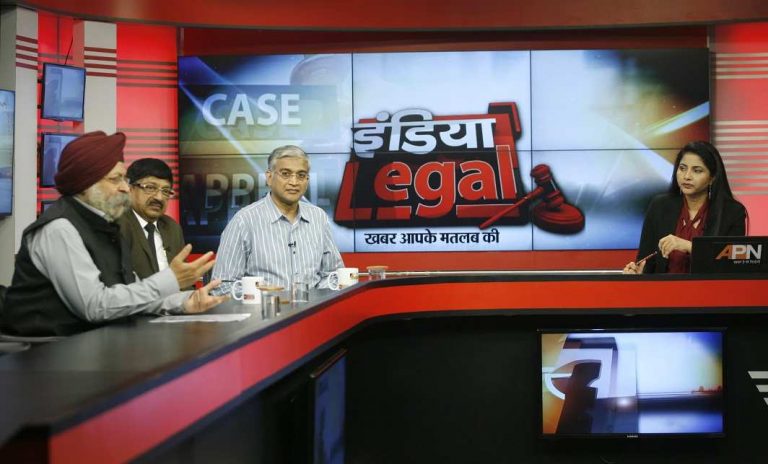
The recent India Legal show telecast on APN News took up the issue of Non-performing Assets which have eaten into the vitals of India’s economy
State-owned banks in India are today bleeding due to Non-performing Assets, or NPAs. By March 2017, the NPAs had increased to more than Rs six lakh crore. According to reports from parliament’s Public Accounts Committee, the corporate sector owes around 70 per cent of the total NPAs.
India currently has 34 Debts Recovery Tribunals (DRTs) and five Debts Recovery Appellate Tribunals for bank loans’ recovery. They together disposed of 16,000 cases in FY 2015-16 and Rs 34,000 crore were recovered. In the same financial year, NPAs worth around Rs 4,429 billion were taken up by lok adalats, DRTs or scrutinised under various security acts. But only 10 per cent of the amount could be actually recovered.
The Supreme Court has taken the issue of NPAs seriously and asked the centre whether complete loan recovery was possible under the existing laws. It has also asked the RBI to furnish details about companies which were yet to clear loans of more than Rs 500 crore. Inordinate delays in solving such cases of corporates have also attracted the top court’s attention.
The Court’s overall approach on the issue has raised hopes that a tough verdict is in the pipeline and a new stringent policy will be formed.
So what does Non-Performing Assets (NPAs) actually mean? How come corporates escape with huge loans and cock a snook at the law? Does the fault lie within the banking system which favours corporates? Can NPAs be actually avoided by banks?
The recent India Legal show took up the issue of the NPA mess in the country. The panelists included senior advocate, Supreme Court, Pallav Sisodia; cyber law expert Pavan Duggal; former chairman, North India region, Institute of Chartered Accountants Anil Agarwal; president, Supreme Court bar Association, Rupinder Singh Suri; senior advocate Gopal Subramaniam; banker Meera Sanyal, and senior advocate Supreme Court Virendra Ganda. Excerpts from the discussions:
Anil Agarwal: The process adopted by banks while sanctioning a loan looks so strong (at face value) that one can’t imagine that recovery could ever be a problem. But in case of corporate loans, it has been observed that the individual becomes richer and richer, while the company becomes poorer and poorer. The banks need to be vigilant on this aspect. There is undue influence. Result: piling up NPAs.
Meera Sanyal: The problem is serious. There are still many non-recognised NPAs despite the official figure touted. Former RBI chairman Raghuram Rajan had said that India faces a peculiar situation where there are many sick industries but no corporate honcho is “sick” (sic). In foreign countries, the responsibility for NPAs is fixed on the concerned bank official and the concerned bank. But in our country, loans are sanctioned one after another but there is no responsibility, no accountability. Monitoring needs to be done on the loans given to the corporates. Examine the objective carefully.
Rupinder Suri: The problem is the human factor; somewhere in the system somebody has compromised with his/her vigilance and integrity and mortgaged it, and thus the situation. Today, 57 borrowers owe Rs 85,000 crore. Many laws have been framed by the government to arrest the menace. But the amount is too high. A collective effort is needed by CAs, lawyers, bankers, etc to address the problem and make efforts to solve it.
Pallav Sisodia: Huge loans given to corporates are obviously sanctioned with political and government interference. Therefore, a banker can’t later deal with that corporate entity under normal bank laws or monitor his case closely.
Virendra Ganda: NPA should never be confused with bad debts. NPAs are classified under a specific definition given by the RBI. Bad debts are defined under Companies Act. The problem is not recent. It has only accumulated. What companies actually do is to cleverly get away from the ambit of NPAs. Sometimes bankers resort to additional funding to borrowers so that they can repay.
Anil Agarwal: Strict monitoring of the purpose for which a bank is giving loans should be done without fear or favour. Look at builders. Why are they in trouble today? Because loans taken for one project are being diverted to another project. This has to be monitored by banks. A buyer relies on the system and here the system itself is allowing the funds to be diverted. There is need for accountability.
Rupinder Suri: In most cases, the nominee director of the bank is on the company’s board. So there is collusion. Diversion of funds should be stopped. Excess revaluation while availing loans should be stopped. Strict action should be taken. The current criminal laws are deterrent enough, but there is no intention to execute them.
Pallav Sisodia: Bank nationalisation was done to ensure that the facilities of banking system percolate down to the common man in the country’s interiors. We will have to see whether high-value banking should remain within the government system. Because inherent problems will remain and whatever laws you bring in will have no effect, or less effect. It is only a banker who can regulate high-value loans and monitor them, not a government official. We need to gradually privatise the entire banking system.
Pavan Duggal: The more we move towards digital banking, the more will be the accountability. Today, there are numerous flaws in the banking system and the companies have made the most of it.
Rupinder Suri: The malaise is deep. So we need a quick resolution. The new insolvency code, bankruptcy code tries to achieve that. The specialist bodies should chip in and recover money quickly.
For details, watch the video:
—Compiled by India Legal team

